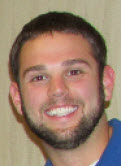An Idea Mapping Success Blogs Weblog
Introducing the First Idea Mapping Guest Blogger – Chris Kordick
12Aug2015 Filed under: Interviews Author: Jamie Nast Today I’m welcoming Chris Kordick as the first guest blogger to this site. I’ve known Chris since 5th grade. He took my Idea Mapping Workshop in August of 2013.
Today I’m welcoming Chris Kordick as the first guest blogger to this site. I’ve known Chris since 5th grade. He took my Idea Mapping Workshop in August of 2013.
In his early 20’s Chris join an elite group of some of the most prolific Idea Mappers I have ever taught. His extensive use of idea maps and memory tools set him apart and give him much credibility – therefore the invitation as a guest blogger.
I first posted about Chris in the fall of 2013 when he was in his last year of pre-med at Benedictine University in Chicago. You can see those two postings about Chris at Idea Map 436 – 1-Year Weightlifting Program Design and Cardiovascular Physiology Student Gets a 92 While Class Average Was 63. How Did He Do It?
Chris is a busy man in his first year of med school at Lake Erie College of Ostepathic Medicine, so we won’t expect frequent posts. But first I need to re-introduce him. Following is the first of three postings about Chris. I recently had the opportunity to interview him. Here are his answers to the first three questions:
1. Prior to attending the Idea Mapping Workshop did you have any preconceived notions about the tool?
In short answer, yes. I am by no means artistic and when I thought of “mapping” I instantly assumed drawing and design. I wondered if the skills taught in the workshop would 1) be applicable to my studies in college and 2) be useful in helping me capture and retain large amounts of information from both lectures and various texts.
2. What were some of the takeaways you had from the course?
I had many! The main one was that Idea Mapping is a set of dynamic skills. One doesn’t need to be Picasso to draw a beautiful map, he/she must simply use whatever means necessary to help with memory retention. Another large takeaway was the ability to condense large amounts of information to a chronologically built map. If noting chapters 1-2 of a dense text, I could do so in order using my own shorthand to create a picture of words that assisted in my recall and retention.
3. How did you apply the memory tools to your schoolwork? What were the results?
I did so in a few different ways. To be honest, I tried to use Idea Mapping live during my lectures, but failed to fully capture all of the information. Instead, I focused from live mapping to study-style mapping. When I would review my linear notes and read my textbooks, I would map out the chapters and turn the linear thoughts into dynamic ones. I also used this technique during pre-recorded lectures because I was able to play them back at reduced speed or pause them as needed.
Once I had my notes, I would read over them and study them in chronological order. Most of my classes at the time were systems based, and the Idea Mapping allowed me to take the text from the book and piecemeal it together in colorful ways; when studying, this was extremely useful because I could zero in on specific points without funneling through my entire text/lecture notes. It saved invaluable amounts of time and allowed me to remember my notes based on color, pictures, etc.
The results were exciting. I had always been a good student before, but I struggled very hard with test taking. Idea Mapping allowed me to score better on both my multiple choice, and short answer exams! By using the memory tools and Idea Mapping, I was able to pull information out of my memory faster and answer multiple choice questions more effectively because I could call more facts to mind than before. My long-term memory recall had drastically improved which allowed me to review for final exams instead of study for them. While my classmates had to flip through notebooks and PowerPoints full of information, I simply pulled out my ten idea maps (one for each chapter) and reviewed.
Thanks for your time Chris! I look forward to sharing the rest of the interview with you.
Idea Mapping Blog
The purpose of this blog is to share idea mapping examples and related learning from my Idea Mapping, Memory, Speed Reading, and Certification Workshops. This blog is dedicated to my Certified Idea Mapping Instructors, my clients, Mind Mapping and Idea Mapping practitioners around the globe.
![[Ask]](http://ideamapping.ideamappingsuccess.com/IdeaMappingBlogs/wp-content/plugins/bookmarkify/ask.png)
![[del.icio.us]](http://ideamapping.ideamappingsuccess.com/IdeaMappingBlogs/wp-content/plugins/bookmarkify/delicious.png)
![[Digg]](http://ideamapping.ideamappingsuccess.com/IdeaMappingBlogs/wp-content/plugins/bookmarkify/digg.png)
![[Facebook]](http://ideamapping.ideamappingsuccess.com/IdeaMappingBlogs/wp-content/plugins/bookmarkify/facebook.png)
![[Google]](http://ideamapping.ideamappingsuccess.com/IdeaMappingBlogs/wp-content/plugins/bookmarkify/google.png)
![[MySpace]](http://ideamapping.ideamappingsuccess.com/IdeaMappingBlogs/wp-content/plugins/bookmarkify/myspace.png)
![[Slashdot]](http://ideamapping.ideamappingsuccess.com/IdeaMappingBlogs/wp-content/plugins/bookmarkify/slashdot.png)
![[Sphinn]](http://ideamapping.ideamappingsuccess.com/IdeaMappingBlogs/wp-content/plugins/bookmarkify/sphinn.png)
![[StumbleUpon]](http://ideamapping.ideamappingsuccess.com/IdeaMappingBlogs/wp-content/plugins/bookmarkify/stumbleupon.png)
![[Technorati]](http://ideamapping.ideamappingsuccess.com/IdeaMappingBlogs/wp-content/plugins/bookmarkify/technorati.png)
![[ThisNext]](http://ideamapping.ideamappingsuccess.com/IdeaMappingBlogs/wp-content/plugins/bookmarkify/thisnext.png)
![[Twitter]](http://ideamapping.ideamappingsuccess.com/IdeaMappingBlogs/wp-content/plugins/bookmarkify/twitter.png)
![[Webride]](http://ideamapping.ideamappingsuccess.com/IdeaMappingBlogs/wp-content/plugins/bookmarkify/webride.png)
![[Email]](http://ideamapping.ideamappingsuccess.com/IdeaMappingBlogs/wp-content/plugins/bookmarkify/email.png)
Leave a reply